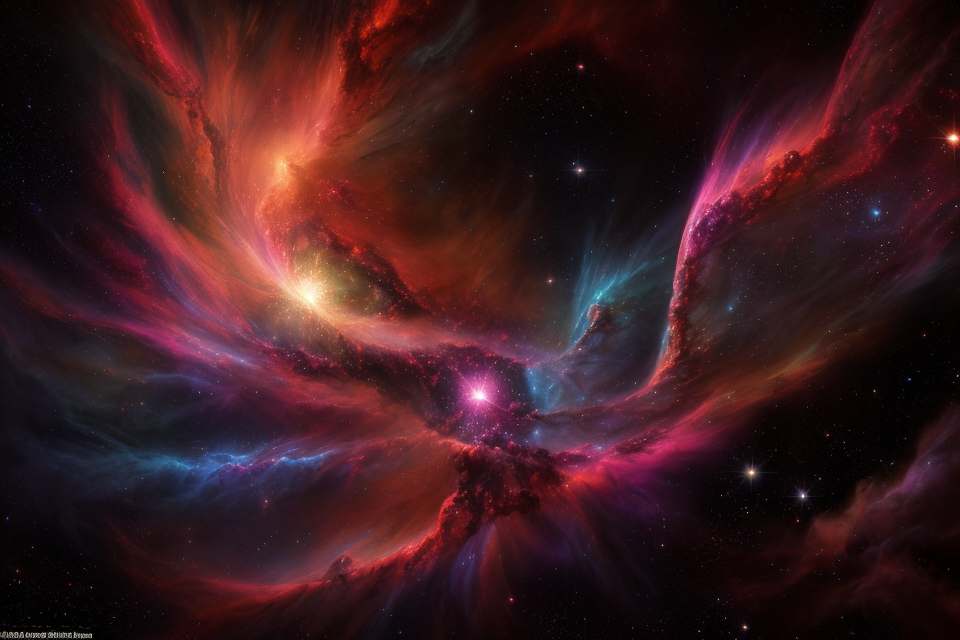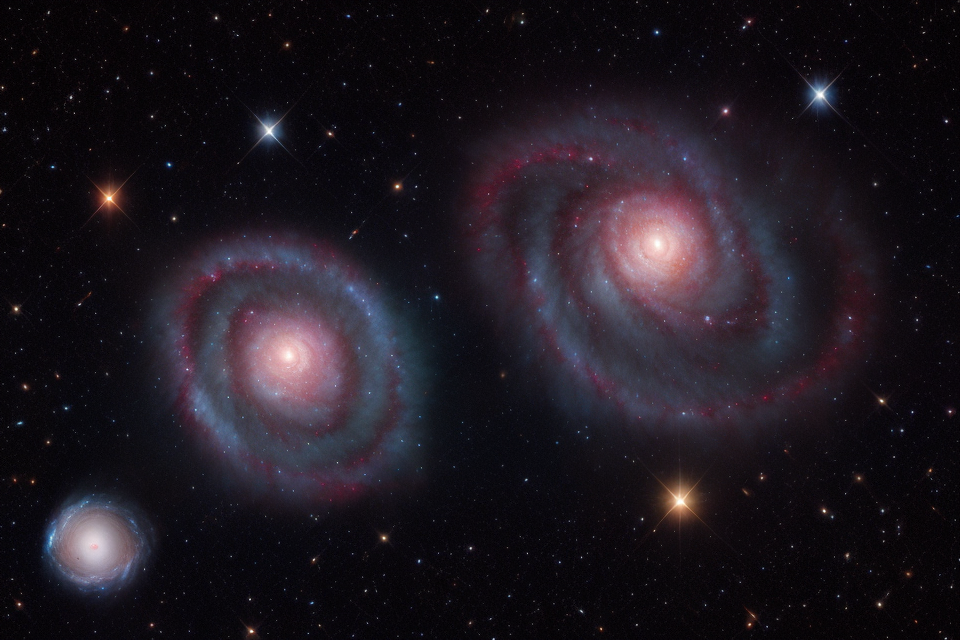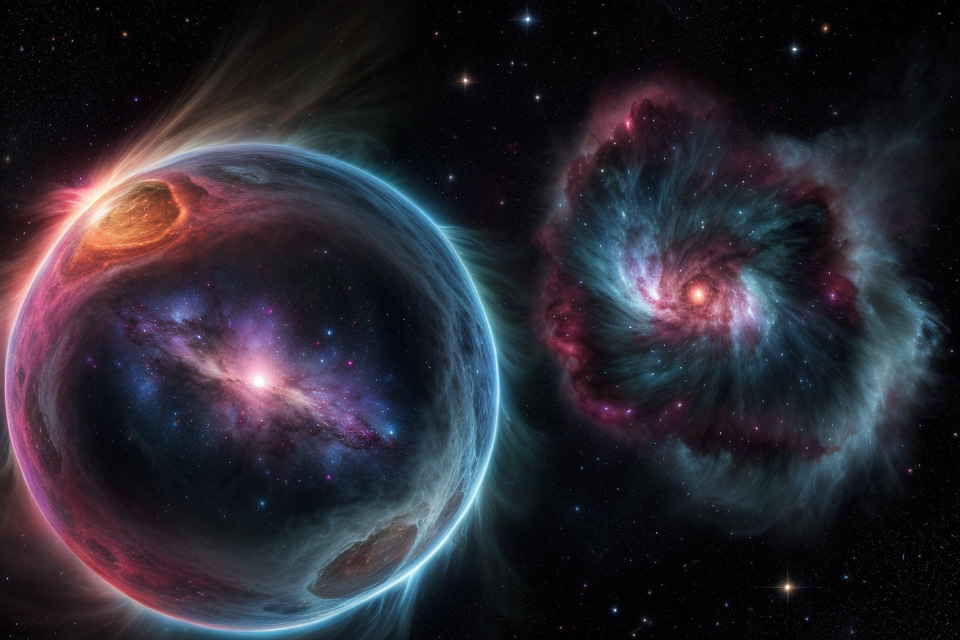Welcome to the fascinating world of nebulas! These glowing gas clouds are some of the most breathtaking sights in the universe, and there’s no better way to explore their beauty than with this comprehensive guide. From the swirling colors of the Orion Nebula to the vast expanse of the Crab Nebula, we’ll take a journey through the cosmos to discover the wonders of these celestial phenomena. So buckle up and get ready to be amazed by the beauty and complexity of the universe’s most awe-inspiring nebulas.
What are Nebulas?
Types of Nebulas
Planetary Nebulas
- Characteristics and Formation
- These nebulas are formed when a star in the late stages of its life begins to shed its outer layers of gas and dust into space.
- They are typically round or ellipsoidal in shape and have a distinct brightness and color.
- The gas and dust are ionized by the star’s intense ultraviolet radiation, which makes them glow and emit light across a range of wavelengths.
- Importance in Stellar Evolution
- Planetary nebulas are an important stage in the evolution of stars, marking the transition from a bright, hot star to a dimmer, cooler star or a white dwarf.
- They also play a role in the enrichment of the interstellar medium with heavy elements, which can then be used to form new stars and planets.
- Notable Examples
- The Ring Nebula (M57) is one of the most studied and well-known planetary nebulas, located about 6,000 light-years away from Earth in the constellation Lyra.
- The Cat’s Eye Nebula (NGC 6543) is another well-known example, located about 10,000 light-years away in the constellation Draco.
- Observational Challenges
- One of the main challenges in studying planetary nebulas is their relatively low surface brightness, which makes them difficult to observe with ground-based telescopes.
- However, with the use of special filters and advanced imaging techniques, planetary nebulas can be studied in greater detail than ever before.
- Future Research Directions
- Future research on planetary nebulas may focus on understanding the physical processes that drive their formation and evolution, as well as their role in the broader context of the universe.
Emission Nebulas
+ Emission nebulas are formed when ionized gas is excited <strong>by intense ultraviolet radiation from</strong> nearby stars, causing it to emit light across a range of wavelengths.
+ They are typically found in regions of active star formation, such as in giant molecular clouds.
- Importance in Star Formation and Evolution
- Emission nebulas are important in the context of star formation, as they indicate the presence of dense, star-forming regions in the interstellar medium.
- They also provide insight into the early stages of star formation and the processes that drive the formation of new stars.
- The Orion Nebula (M42) is one of the most well-known emission nebulas, located about 1,500 light-years away in the constellation Orion.
- The Horsehead Nebula (Barnard 33) is another famous example, located about 15 light-years away in the constellation Orion.
- Emission nebulas can be challenging to study due to their brightness and proximity to other celestial objects.
- However, with the use of special filters and advanced imaging techniques, emission nebulas can be studied in greater detail than ever before.
- Future research on emission nebulas may focus on understanding the physical processes that drive their formation and evolution, as well as their role in the broader context of the universe.
Reflection Nebulas
+ Reflection nebulas are formed when light from a nearby star is reflected off of the dust and gas in a nebula.
+ They are typically found in regions of star formation, where the dust and gas are being heated and ionized <strong>by intense ultraviolet radiation from</strong> nearby stars.
+ Reflection nebulas are important in the context of star formation, as they indicate the presence of dense, star-forming regions in the interstellar medium.
+ They also provide insight into the processes that drive the formation of new stars.
+ The
The Science Behind Nebulas
Nebula Formation Theories
Stellar Wind and Supernova Explosions
- How Stellar Winds Shape Nebulas
Stellar winds, the continuous outflow of gas from massive stars, play a crucial role in nebula formation. These winds, comprised primarily of hydrogen and helium, carry away mass and momentum from the star, creating a bubble-like structure around the star. Over time, the stellar wind collides with the surrounding interstellar medium, compressing and heating the gas, causing it to emit light in various wavelengths, resulting in the beautiful and colorful nebulae we observe today. - Supernova Impact on Nebulas
Supernovae, the violent explosions of massive stars, can also contribute to nebula formation. When a massive star exhausts its fuel, it can collapse under its own gravity, causing a supernova event. The shockwave generated by the supernova can compress and heat the surrounding interstellar medium, leading to the formation of a supernova remnant, which is essentially a dense, expanding shell of gas and dust. These remnants can also interact with existing nebulae, influencing their shape and color.
Understanding the intricacies of nebula formation and the various factors that contribute to their appearance is an ongoing area of research. Scientists continue to study the interplay between stellar winds, supernovae, and the surrounding interstellar medium to better understand the complex processes that lead to the creation of these stunning celestial objects. Future research may also focus on the role of magnetic fields and turbulence in shaping nebulae and the impact of cosmic rays on their evolution.
Observing Nebulas
Telescopes and Instruments
Optical Telescopes
Optical telescopes are a primary tool for observing nebulas, as they allow astronomers to study the colors, shapes, and patterns of these glowing gas clouds in great detail. Optical telescopes capture light from the nebulas and translate it into images that can be analyzed and interpreted. The most common type of optical telescope used for nebula observation is the reflecting telescope, which uses a mirror to gather and focus light.
Advantages and Limitations
Optical telescopes offer several advantages when observing nebulas. They can produce high-resolution images, which allows astronomers to study the intricate details of nebulas and learn more about their structure and composition. Additionally, optical telescopes can be used to observe a wide range of wavelengths, including visible and ultraviolet light, which is important for studying the different types of nebulas and the processes that drive their emission.
However, optical telescopes also have limitations when observing nebulas. For example, they are only able to observe nebulas that emit light in the visible spectrum, which means that they cannot study nebulas that emit only infrared or radio waves. Additionally, the quality of the images produced by optical telescopes can be affected by atmospheric conditions, such as air turbulence and cloud cover, which can blur or distort the images.
Notable Examples
Some notable examples of optical telescopes used for nebula observation include the Hubble Space Telescope, the Keck Observatory, and the Very Large Telescope (VLT). These telescopes have been instrumental in studying many different types of nebulas and advancing our understanding of these celestial objects.
Future Developments
Future developments in optical telescope technology are likely to continue to improve our ability to observe nebulas. For example, adaptive optics technology, which corrects for atmospheric distortions in real-time, is being developed for use with optical telescopes. This technology has the potential to greatly improve the quality of images produced by optical telescopes, allowing astronomers to study nebulas in even greater detail. Additionally, the development of new materials and technologies for mirrors and lenses may lead to even larger and more powerful optical telescopes in the future.
Nebulas in Popular Culture
Mythology and Folklore
Ancient Civilizations and Nebulas
Nebulas have been a source of fascination for ancient civilizations, with many cultures incorporating them into their myths and legends. The Dogon people of Mali, for example, have a tradition that their ancestors were taught about the star Sirius and its companion star, Sirius B, by a superior being known as Amma. According to this legend, Amma brought the Dogon to the star system and taught them about the nebula surrounding Sirius B, which they called “Emme ya.”
Another example is the Norse myth of the burning wheel, which describes a great wheel of fire that circles the earth. This wheel is believed to be the source of the aurora borealis, which is caused by charged particles from the sun interacting with the Earth’s magnetic field. Some scholars believe that the Norse may have been describing a nebula, such as the Orion Nebula, which appears as a burning wheel in the night sky.
Examples from Around the World
Nebulas have been incorporated into the myths and legends of many cultures, each with their own unique interpretations and meanings. In Chinese culture, for example, the nebula in the constellation Cassiopeia is known as the “Queen Mother of the West,” and is associated with the goddess of the earth. The Hopi people of North America have a tradition of performing a dance known as the “Night Chant,” which includes references to the starry sky and the nebulae that can be seen within it.
Cultural Significance
Nebulas have played a significant role in the cultural and religious practices of many societies throughout history. They have been used as navigational tools, as symbols of creation and destruction, and as sources of inspiration for art and literature. Despite our modern understanding of these cosmic phenomena, the awe and wonder that they have inspired throughout history continues to captivate us today.
Protecting Nebulas for Future Generations
Astronomy and Conservation
Importance of Dark Sky Preserves
- Dark sky preserves play a crucial role in the conservation of nebulas by protecting them from light pollution.
- These protected areas provide optimal conditions for astronomical observation and research, enabling scientists to study the nebulas in their natural state.
- Dark sky preserves also offer unique opportunities for the general public to appreciate the beauty and wonder of the night sky, fostering a deeper connection between humans and the cosmos.
Benefits for Astronomy and Wildlife
- Preserving dark skies allows for more accurate and detailed observations of nebulas, leading to a better understanding of their physical properties and evolution.
- Dark sky preserves help minimize the negative impact of artificial lighting on nocturnal wildlife, ensuring the survival of species that rely on a dark environment for survival.
- These protected areas promote ecological balance and biodiversity, contributing to the overall health of the planet.
Challenges and Success Stories
- Despite the benefits of dark sky preserves, they face challenges such as encroachment from urbanization, inadequate enforcement of regulations, and lack of public awareness.
- Successful examples of dark sky preserves include the Grand Canyon National Park in the United States and the Snowdonia National Park in Wales, which have demonstrated the positive impact of protecting the night sky on both astronomy and wildlife.
Future of Dark Sky Preserves
- As the demand for dark sky preserves continues to grow, it is essential to develop new strategies for protecting these areas and raising public awareness about their importance.
- Collaboration between government agencies, non-governmental organizations, and local communities will be crucial in ensuring the long-term success of dark sky preserves.
- Technological advancements in lighting solutions and monitoring techniques offer promising avenues for mitigating light pollution and safeguarding the night sky.
The Future of Nebula Research
Technological Advancements
Telescope Design and Materials
Currently, telescopes are limited in their ability to study nebulas due to factors such as light pollution, atmospheric interference, and technical limitations. However, ongoing research is aimed at developing new telescope designs and materials that can overcome these challenges.
One promising area of research is the development of adaptive optics, which uses deformable mirrors to correct for the distortions caused by the Earth’s atmosphere. This technology has already been successfully implemented in ground-based telescopes, and is expected to greatly improve the resolution and sensitivity of future space-based telescopes.
Another area of focus is the development of new materials for telescope mirrors and other components. For example, researchers are exploring the use of carbon nanotubes and other advanced materials to create mirrors that are lighter, stronger, and more reflective than traditional glass mirrors.
Potential Impact on Nebula Research
The development of new telescope technologies and materials has the potential to revolutionize our understanding of nebulas. With improved resolution and sensitivity, astronomers will be able to study these objects in greater detail than ever before, revealing new insights into their structure, composition, and evolution.
Data Analysis and Machine Learning
Data analysis and machine learning are also playing an increasingly important role in nebula research. With the advent of large-scale surveys such as the Sloan Digital Sky Survey, astronomers are now able to collect vast amounts of data on nebulas and other celestial objects.
To make sense of this data, researchers are turning to machine learning algorithms that can automatically identify and classify different types of nebulas based on their spectral characteristics. This approach has the potential to greatly speed up the process of analyzing large datasets, allowing astronomers to focus their attention on the most interesting and important objects.
Applications in Nebula Studies
Applications of data analysis and machine learning in nebula studies are numerous. For example, researchers are using these techniques to identify the types of stars and other objects that are responsible for creating different types of nebulas. They are also using machine learning to study the dynamics of nebulas, such as their expansion and collapse, and to model the evolution of these objects over time.
Future Developments and Opportunities
As data analysis and machine learning techniques continue to improve, there is great potential for further advances in nebula research. For example, researchers are exploring the use of artificial intelligence to develop predictive models of nebula formation and evolution, which could aid in the discovery of new types of nebulas and the study of their properties.
Additionally, the integration of multi-wavelength data from different observing platforms, such as ground-based telescopes, space-based observatories, and even citizen science projects, holds great promise for uncovering new insights into the nature of nebulas and their role in the universe.
Exploring New Frontiers
Studying Nebulas in Other Galaxies
Challenges and Opportunities
- Challenges:
- Limited resolution due to the vast distances between Earth and other galaxies
- Difficulty in studying specific regions within nebulas in other galaxies
- Competition with other scientific priorities and funding constraints
- Opportunities:
- Advancements in technology, such as larger telescopes and space-based observatories, are enabling more detailed studies of nebulas in other galaxies
- The detection of gravitational waves and neutrinos from astronomical events can provide new insights into the physics of nebulas
- The development of new techniques, such as machine learning and data mining, can help extract valuable information from large datasets
Future Missions and Telescopes
- Upcoming missions:
- The James Webb Space Telescope (JWST) is set to launch in 2021 and will provide unprecedented observations of nebulas in other galaxies, particularly in the infrared spectrum
- The Wide Field Infrared Survey Telescope (WFIRST) is a proposed mission that aims to study dark energy and explore the structure of the universe, including nebulas in other galaxies
- Current and past missions:
- The Hubble Space Telescope (HST) has provided a wealth of information on nebulas in other galaxies, particularly in the visible and ultraviolet spectra
- The Spitzer Space Telescope has studied nebulas in the infrared spectrum, providing unique insights into the cooler regions of nebulas
Nebula Research and the Search for Extraterrestrial Life
Implications for Astrobiology
- Implications:
- Nebula research can provide valuable information on the chemical and physical conditions necessary for the formation of planets and the emergence of life
- Studying the evolution of nebulas and the formation of stars can shed light on the potential habitability of exoplanets
- Future Research Directions:
- Investigating the role of nebulas in the chemical evolution of galaxies and the potential transport of life-enabling molecules between planetary systems
- Exploring the connection between nebulas and the formation of black holes, which could have implications for the detection of extraterrestrial civilizations
- Studying the influence of magnetic fields and radiation on the formation of planets and the emergence of life in nebulas
FAQs
1. What are nebulas?
Nebulas are glowing gas clouds in space that are illuminated by the light of nearby stars. They are composed of hydrogen, oxygen, and other elements that are ionized by the intense heat and energy produced by these stars. Nebulas can be found throughout the universe and come in a variety of shapes and sizes.
2. How many nebulas are there in the universe?
It is difficult to say exactly how many nebulas there are in the universe, as they are constantly changing and evolving. However, estimates suggest that there are millions of nebulas in our own Milky Way galaxy alone, and billions of nebulas in the observable universe.
3. What are some of the most famous nebulas?
Some of the most famous nebulas include the Horsehead Nebula, the Swan Nebula, the Orion Nebula, and the Crab Nebula. These nebulas are particularly well-known because they are visible from Earth and have been studied in detail by astronomers.
4. How are nebulas formed?
Nebulas are formed when hot gas and dust from nearby stars are blown out into space. This material can then cool and condense into new stars, planets, and other celestial bodies. Nebulas can also be formed when two stars collide and release a tremendous amount of energy and matter into space.
5. Can we visit nebulas?
Currently, it is not possible for humans to visit nebulas directly. However, advances in space travel and technology may one day allow us to explore these fascinating objects up close. In the meantime, astronomers continue to study nebulas from Earth and learn more about their properties and behavior.



